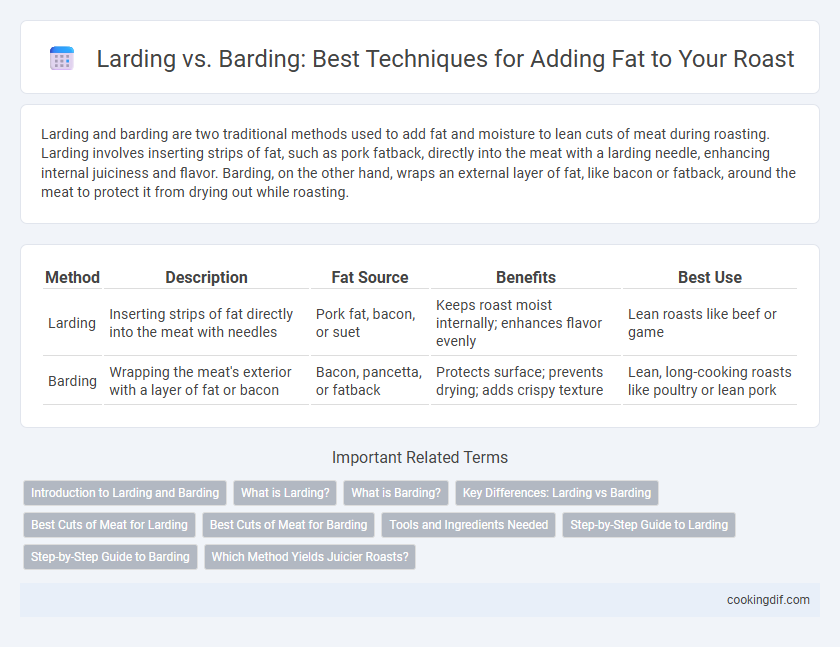Larding and barding are two traditional methods used to add fat and moisture to lean cuts of meat during roasting. Larding involves inserting strips of fat, such as pork fatback, directly into the meat with a larding needle, enhancing internal juiciness and flavor. Barding, on the other hand, wraps an external layer of fat, like bacon or fatback, around the meat to protect it from drying out while roasting.
Table of Comparison
| Method | Description | Fat Source | Benefits | Best Use |
|---|---|---|---|---|
| Larding | Inserting strips of fat directly into the meat with needles | Pork fat, bacon, or suet | Keeps roast moist internally; enhances flavor evenly | Lean roasts like beef or game |
| Barding | Wrapping the meat's exterior with a layer of fat or bacon | Bacon, pancetta, or fatback | Protects surface; prevents drying; adds crispy texture | Lean, long-cooking roasts like poultry or lean pork |
Introduction to Larding and Barding
Larding involves inserting strips of fat directly into lean meat to enhance moisture and flavor during roasting, providing internal fat distribution for juicier results. Barding refers to wrapping the meat's exterior with a layer of fat, such as bacon or fatback, to protect it from drying out while roasting. Both techniques improve roast tenderness and taste but differ in the fat's placement and method of fat incorporation.
What is Larding?
Larding is a traditional technique that involves inserting thin strips of fat, typically pork fatback, directly into lean cuts of meat using a special larding needle to enhance moisture and flavor during roasting. This method ensures the fat melts internally, keeping the roast juicy and tender throughout cooking. Larding is especially beneficial for lean roasts like venison or beef, where natural fat content is low.
What is Barding?
Barding is a culinary technique that involves wrapping lean meat, such as roast beef or game, with strips of fat like bacon or pork fatback to keep the meat moist during cooking. This method prevents the roast from drying out by slowly rendering fat over the surface, enhancing flavor and juiciness. Unlike larding, which inserts fat internally, barding adds a protective fat layer externally, especially beneficial for lean cuts.
Key Differences: Larding vs Barding
Larding involves inserting strips of fat directly into lean meat using a larding needle, enhancing moisture and flavor from within, while barding entails covering the meat's surface with fat like bacon or fatback to protect it during roasting. Larding is ideal for smaller, lean cuts requiring internal fat infusion, whereas barding suits larger roasts needing external fat coverage to prevent drying. The choice between larding and barding affects cooking time, texture, and flavor infusion, with larding offering more uniform fat distribution inside the meat.
Best Cuts of Meat for Larding
Larding enhances lean cuts like beef tenderloin, pork loin, and veal roast by inserting strips of fat directly into the meat, ensuring moisture and rich flavor during roasting. This technique is ideal for cuts that lack intramuscular fat but require added juiciness and tenderness. Choosing prime cuts such as sirloin or leg of lamb maximizes larding effectiveness, preserving succulence through extended cooking times.
Best Cuts of Meat for Barding
Barding adds a protective layer of fat to lean cuts like beef tenderloin, venison, or poultry breast, enhancing moisture retention and flavor during roasting. Opt for cuts such as eye of round, sirloin tip, or pork loin when barding to prevent drying out while maintaining tenderness. These lean, fine-grained meats benefit most from barding, ensuring a juicy and flavorful roast.
Tools and Ingredients Needed
Larding requires using a larding needle or skewer to insert strips of fat, typically pork fatback or bacon, directly into the meat. Barding involves wrapping the entire roast with thin slices of fatty ingredients like prosciutto, pancetta, or bacon, using kitchen twine or toothpicks to secure the fat in place. Both techniques rely on quality, high-fat cuts to enhance moisture and flavor during roasting.
Step-by-Step Guide to Larding
Larding enhances roast juiciness by inserting strips of fat directly into the meat using a larding needle, improving flavor and moisture retention during cooking. The step-by-step guide to larding involves selecting firm pork fat, sterilizing a larding needle, piercing the meat to create channels, and threading fat strips evenly throughout the roast. This technique differs from barding, which wraps external fat over the meat surface, making larding ideal for lean cuts requiring internal fat infusion.
Step-by-Step Guide to Barding
Barding involves wrapping a lean roast with strips of fat, such as bacon or pork fatback, to maintain moisture and enhance flavor during cooking. To bard effectively, start by trimming the roast and securing the fat strips around it with kitchen twine or skewers, ensuring even coverage without overlapping. This technique creates a protective barrier that promotes juiciness and adds richness, especially beneficial for lean cuts like venison or beef round.
Which Method Yields Juicier Roasts?
Larding involves inserting strips of fat directly into the meat, ensuring internal moisture retention and enhanced juiciness throughout the roast. Barding wraps the roast externally with a layer of fat, such as bacon or fatback, which bastes the meat during cooking but may result in less uniform fat distribution. Larding typically yields juicier roasts by delivering fat directly inside the muscle fibers, preventing dryness more effectively than barding.
Larding vs barding for adding fat Infographic

 cookingdif.com
cookingdif.com